
Large-scale testing has begun to support an initiative aimed at storing carbon emissions in the subsurface of the North Sea.
Project Greensand is being driven by a consortium of 23 different Danish and international partners, led by petrochemicals giant Ineos.
The carbon capture and storage scheme is the most mature of its kind in the country, and was awarded £22 million by the Danish Government last year.
It has the potential to lock away up to 1.5 million tons of CO2 per year by the end of 2025, rising to 8 million tons per year by 2030.
Emissions will be stored in the Ineos-operated Nini West field, in the Siri area offshore Denmark.
Solutions provider Welltec has now kicked off extensive testing to identify optimal materials for Project Greensand.
The launch of the company’s newly developed Test Flow Loop – a test installation of 18 x 5 meters –allows for essential corrosion testing, where the performance of five different materials will be compared in a controlled environment.
Linda Nolting Kristensen, technology innovation lead at Welltec, said: “We recreate the subsea environment of the North Sea and expose the materials to that environment for a long period, so we find out which materials are best suited to function over time.”
To identify the final materials, Welltec has designed two test phases.
In the first stage, five different materials are tested, and the results will form the basis for further qualification later in the project.
Ultimately, the tests will be decisive in the recommendation of which materials Project Greensand should proceed with for the casing pipes, which run all the way down to the reservoir of sandstone 1,800 meters below the seabed.
Ms Kristensen added: “At Welltec, we are happy and proud to be part of Project Greensand. We have made a meaningful investment in our Test Flow Loop, and also gained valuable experience in the energy transition. It is an important area for us – both for our business and equally for our desire to contribute to reducing CO2 emissions through CO2 storage.”
Welltec’s work marks another step forward in Project Greensand, with tank containers, ships, and developed designs for the pump systems already secured.
First storage of CO2 in the subsurface of the North Sea is expected around the end of the year.
Soren Reinhold Poulsen, project director for Project Greensand, said: “We look forward to following the testing process at Welltec closely. They have extensive experience in offshore pipes, and we are sure that they can take on the task so that we can reach the goal together. It is crucial for us that we select the right materials for the dedicated CO2 injection wells for Project Greensand, so that in the future we can store CO2 safely in the Danish subsea.”
Recommended for you

